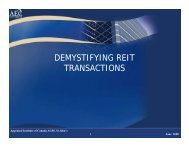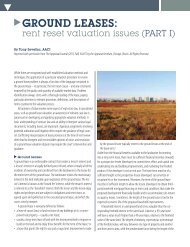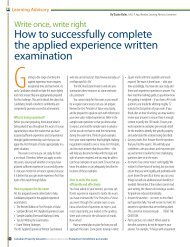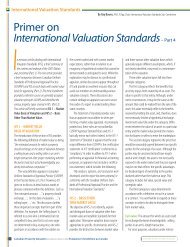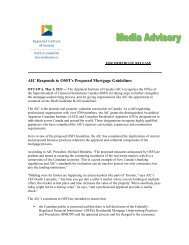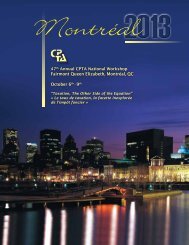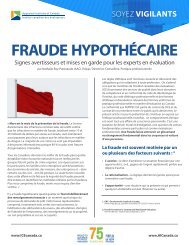Strategic asset management (real property)By Gordon E. MacNair, AACI, P. App, Director, Real Estate Partnerships & Development Office, City <strong>of</strong> OttawaOverviewThe purpose <strong>of</strong> this article is to review the complexities associatedwith real property asset management. The process begins withunderstanding the need and the owner’s objectives, planning, movingthrough the acquisition phase, the operation and maintenance phase,the refurbishment and enhancement phase, and, finally, the disposition<strong>of</strong> the asset. The article also explores the importance <strong>of</strong> having strategicpr<strong>of</strong>essional staff oversee asset management on behalf <strong>of</strong> the ownership.Asset management can be defined as the process <strong>of</strong> creating valuewithin the owner’s objectives through the acquisition, use and disposal<strong>of</strong> real property assets. Alternatively, asset management is defined as thepractice <strong>of</strong> maximizing the value <strong>of</strong> a portfolio <strong>of</strong> properties, within theobjectives <strong>of</strong> the owner 1 .While a real estate appraiser’s job is to place a value on the futurebenefits <strong>of</strong> a particular property, an asset manager has to realize thosebenefits. However, this article will demonstrate how the real estate appraiserassists the asset manager throughout the asset management cycle.The Phases <strong>of</strong> the Real Property Asset Life CycleDISPOSEREFURBISH ORENHANCEDEFINE THE NEEDFOR THE ASSETplancreate oracquireOPERATE ORMAINTAINThe process for asset management involves identifying the need andowner’s objectives for the requirement followed by five phases: planning,acquisition, operating and maintenance, refurbishment or enhancement,and, finally, disposal. This is illustrated in Figure 1 – The Phases <strong>of</strong> theReal Property Asset Life Cycle 2 .As outlined in the text, Corporate Property Management: AligningReal Estate with Business Strategy 3 by Victoria Edwards and Louise Ellison,property is a ‘corporate asset’ and is held for one <strong>of</strong> two purposes:• as an investment asset, or• as an operational asset.Property held as an investment asset, like any other investment asset,is expected to earn a rate <strong>of</strong> return on capital employed for the holderand, particularly in the case <strong>of</strong> freehold, appreciate in capital value.Property held as an operational asset serves to support the activities <strong>of</strong>the business occupying the property. This type <strong>of</strong> property is sometimesreferred to as ‘corporate property.’It is the author’s opinion that there is a difference between private andpublic sector real estate objectives. From a private perspective, the primarydriver is financial, since, typically, there must be an acceptable return onthe investment and capital appreciation (it is recognized that, with currentmarket demand, environmental sustainability needs to be analyzed inorder to address greening initiatives such as LEED, BOMA BESt, etc.). Withthe public sector, the objectives are broader and consist <strong>of</strong> the four pillars(financial, social, cultural, and environmental). As a result, it is a matter <strong>of</strong>balancing the various pillars to accomplish organizational objectives forthe public sector asset manager. An example would be a large tract <strong>of</strong> landowned by the municipality, that has subdivision potential, but over half <strong>of</strong>the parcel is a woodlot, which has natural environmental features. In thisinstance, it is possible that the municipality would probably retain all ormost <strong>of</strong> the woodlot to satisfy its environmental objectives. Clearly, thefinancial return would be greater by permitting housing development, butthis would not allow the municipality to satisfy its environmental objectives.Need for asset and ownership objectivesIt is important to thoroughly understand the need, as this is incorporatedwithin the owner’s objectives as demonstrated in Figure 1. The ownershipobjectives will vary widely among individual, corporate, fiduciary andgovernment owners. In addition to the identification <strong>of</strong> specific assetsthat may align with any defined user need, it is also relevant to considerthe application <strong>of</strong> an effective methodology, which will rationalize theacquisition <strong>of</strong> any asset and will ensure an appropriate and sustainableend-state property solution.42Canadian Property Valuation Volume 54 | book 1 | 2010 Évaluation Immobilière au <strong>Canada</strong>click here to return to table <strong>of</strong> contents
By definition, asset rationalization reduces the risk <strong>of</strong> improperacquisition.Some owners see real estate as an investment, while others use realproperty for their own benefit and are interested in preserving the value<strong>of</strong> their investment. Most institutional and corporate investors have welldefined, written goals in the form <strong>of</strong> policy statements or investmentguidelines that are readily obtainable from their website. An example isBrookfield Properties 4 which “is committed to building shareholder value byinvesting in premier quality <strong>of</strong>fice assets and pro-actively managing each <strong>of</strong>our properties to increase cash flows and maximize return on capital.” Froma public perspective, the City <strong>of</strong> Ottawa is strategically driven to optimizethe value <strong>of</strong> city-owned property holdings based on balancing the City’sfinancial, social, cultural, and environmental objectives for these holdings.PlanningAs John McMahan states in his book The Handbook <strong>of</strong> Commercial RealEstate Investing 5 , the role <strong>of</strong> the asset manager has evolved over thelast 50 years, as real estate has gone from individual to institutionalownership and from the management <strong>of</strong> a few properties in a singlemarket to large portfolios located in <strong>of</strong>ten dispersed geographical areas.The modern real estate asset manager is a multi-disciplined, highlytrainedreal estate pr<strong>of</strong>essional who is expected to not only be responsiblefor managing investment assets during the investment holding period,but be an integral part <strong>of</strong> both the acquisition and disposition process.Below is a list <strong>of</strong> potential objectives for the asset manager as itapplies to strategic asset management:• support <strong>of</strong> corporate objectives, e.g., the four pillars approach (financial,social, cultural and environmental) through redevelopment or otherinitiatives;• implementation <strong>of</strong> asset management strategies for all owned andleased facilities;• provision <strong>of</strong> strategic portfolio planning and expert real estate advice toits ownership to ensure that their real estate needs are met in the mostefficient and effective manner;• generation <strong>of</strong> development strategies with intent to maximize the value<strong>of</strong> corporate real property holdings;• development <strong>of</strong> effective property solution options for ownership thatsupport a balanced and affordable solution;• determination <strong>of</strong> the suitability and affordability <strong>of</strong> the portfolio tomeet the needs <strong>of</strong> all client groups;• development <strong>of</strong> value-added real estate solutions for core andnon-core assets;• development <strong>of</strong> facility and portfolio plans which recommend thedisposition, remediation, redevelopment, retirement and/or retention<strong>of</strong>, and reinvestment in, those properties which are demonstrablysustainable, affordable and appropriately utilized; and• analysis, rationalization, demonstration and communication <strong>of</strong> theaccurate whole-life cost implications <strong>of</strong> real property solutions orpolicies that are introduced in response to the needs <strong>of</strong> clients.AcquisitionThe decision to purchase/lease real estate is found within the owner’sobjectives. Some potential scenarios include:• purchase <strong>of</strong> an existing property;• purchase <strong>of</strong> a vacant site for development;• redevelopment <strong>of</strong> an existing property; or• lease.With any acquisition, the buyer and seller ultimately enter into a Purchaseand Sale Agreement (P & S Agreement). However, in some instances, aLetter <strong>of</strong> Intent may be prepared prior to this stage to outline the potentialbusiness terms. The P & S Agreement serves as a legal contract betweenthe two parties and forms the basis for how the purchaser will obtaincontrol <strong>of</strong> a property.With the purchase <strong>of</strong> real property, proper due diligence must becarried out. Due diligence is the process <strong>of</strong> investigating and verifyinginformation as it pertains to the subject property. Typically, this processstarts before an <strong>of</strong>fer is made. However, once an <strong>of</strong>fer is made, it typicallyincludes clauses that allow completion <strong>of</strong> further due diligence suchas: title search, environmental investigation, building condition audit,designated substance pr<strong>of</strong>iling, engineering and structural reviews, etc.The amount <strong>of</strong> time that a purchaser needs to satisfy due diligencerequirements is a critical part <strong>of</strong> the negotiation process. Clearly, thetransaction cannot close until the due diligence process has beencompleted.Due diligence for a vacant parcel <strong>of</strong> land might include confirmation<strong>of</strong> zoning, <strong>of</strong>ficial plan designation, satisfactory financing, obtaining anappraisal, title search, assessment <strong>of</strong> environmental issues, review <strong>of</strong>survey plan, consultation with the local municipality, determination <strong>of</strong>geotechnical condition <strong>of</strong> soil, private/municipal services, accessibility,review <strong>of</strong> future development in the area, development charges, <strong>of</strong>f-siteobligations, archaeological issues, wetland concerns, etc.Similarly, the due diligence process for an improved property mightinclude the above as well as a building condition audit; and review <strong>of</strong>:life cycle costs, historical operating costs, environmental issues withinclick here to return to table <strong>of</strong> contentsCanadian Property Valuation Volume 54 | book 1 | 2010 Évaluation Immobilière au <strong>Canada</strong> 43



